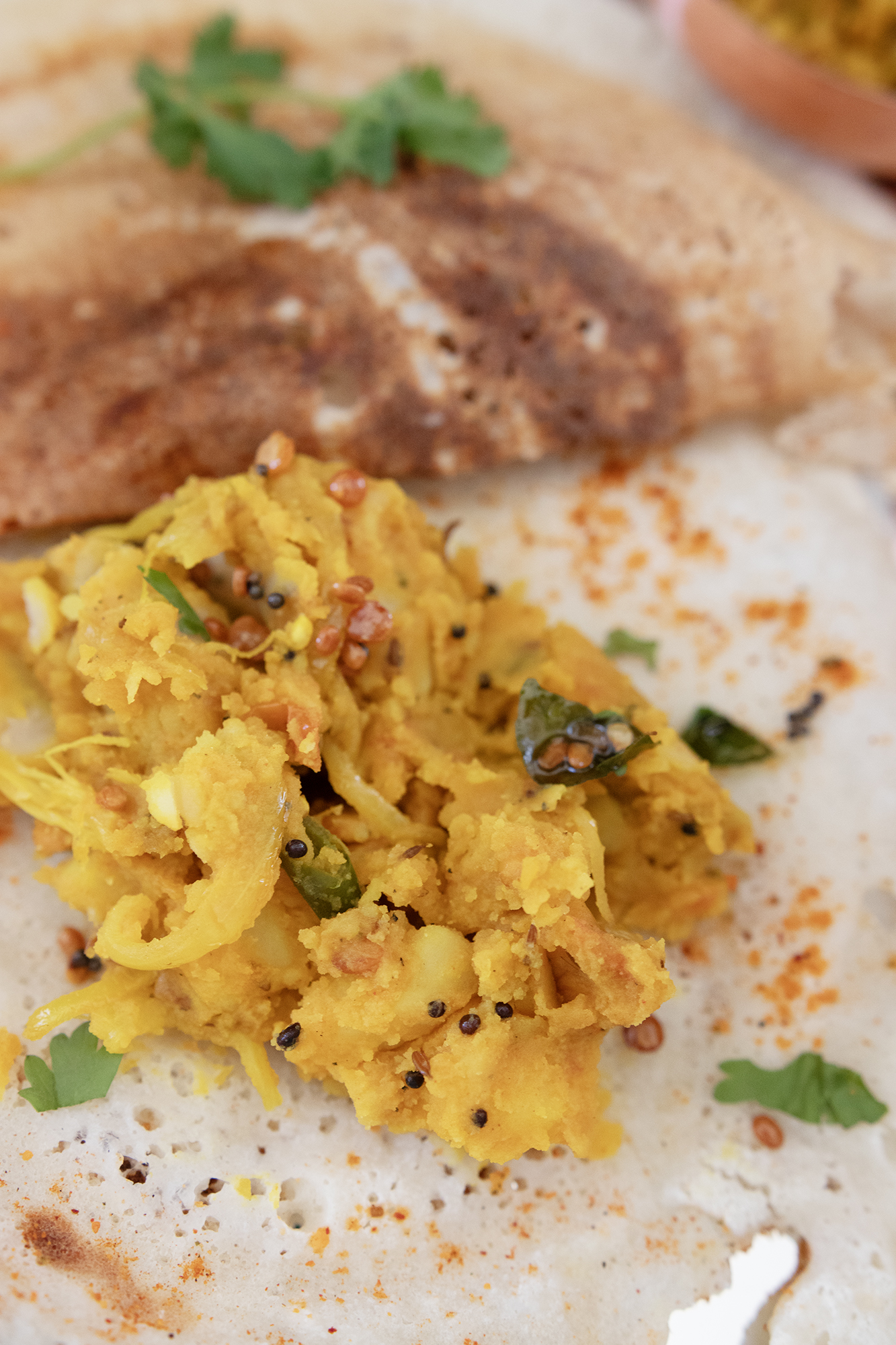
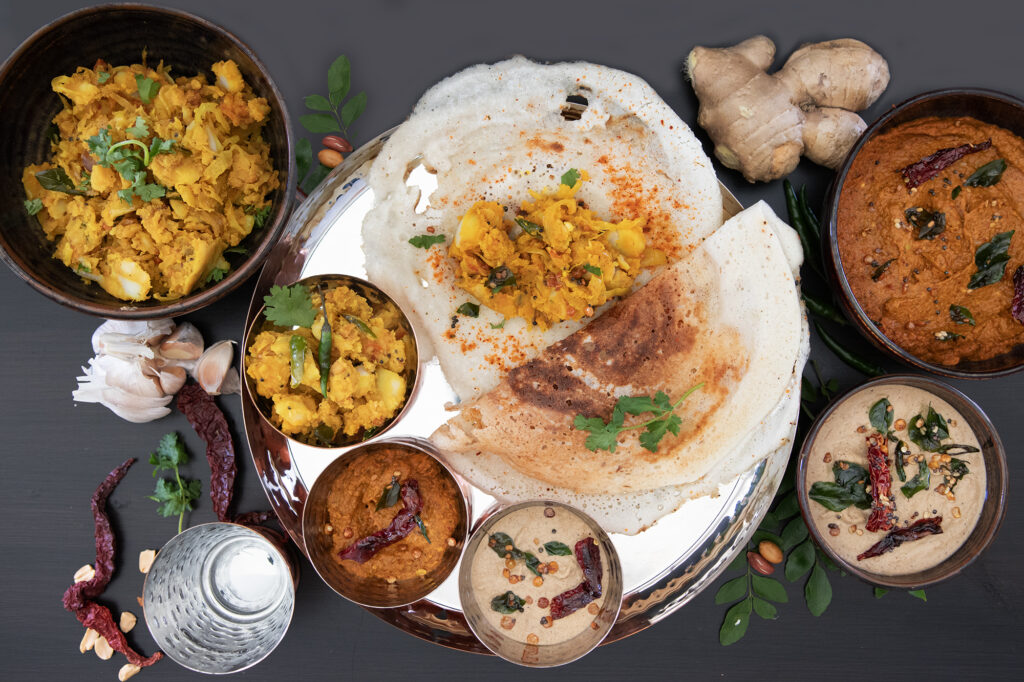
Making a beautiful round and crispy dosa made with a lentil and rice paste is immensely satisfying. Although it’s fairly easy to make it can be finicky till you get the hang of it, go get started and make your Dosa and all the trimmings today!
These days, Dosa & Idli batter is available in most stores. I’m not sure how one batter than make both as Dosa is a runnier batter than an Idli batter that is thicker and cloud like. While I do have to agree that making this is a bit of work, it’s super easy and with simple basic ingredients, you can get a large quantity of batter for many many many Dosas.
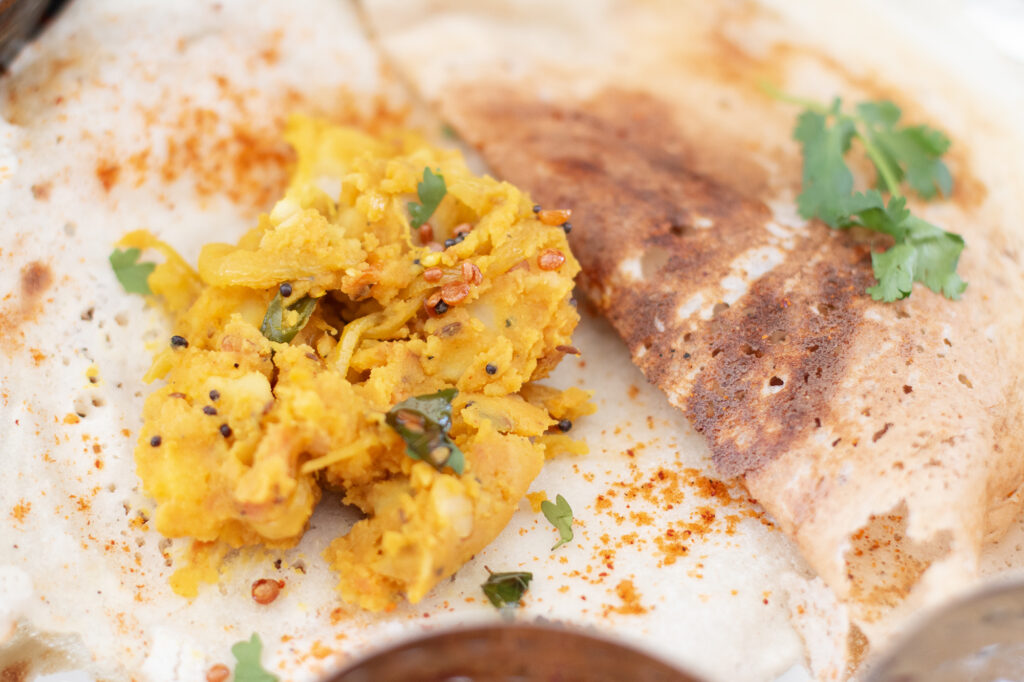
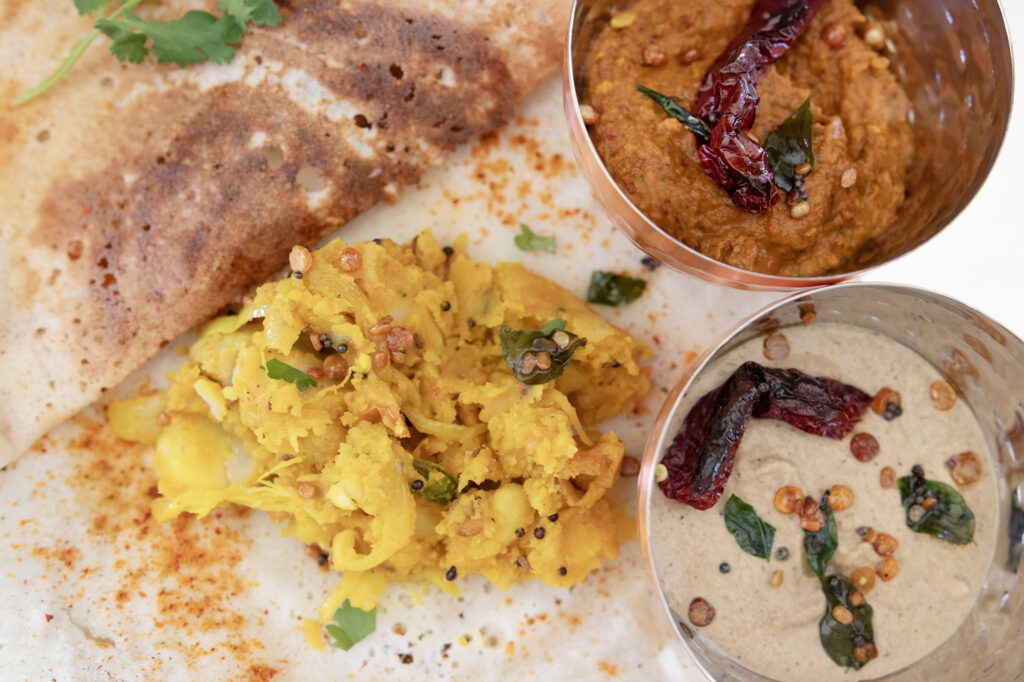
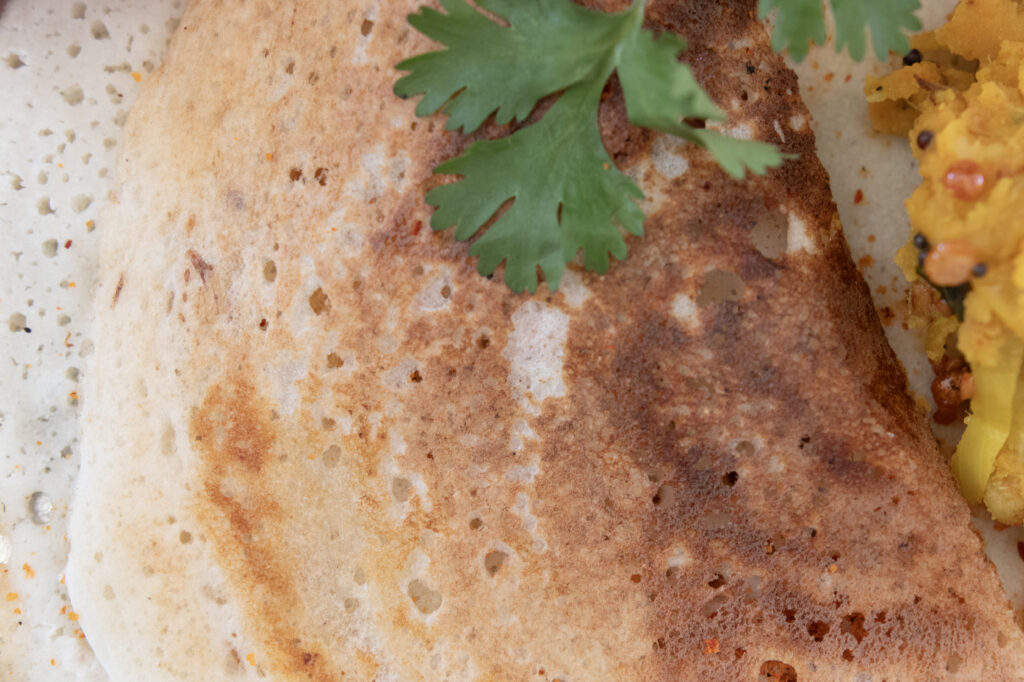
There are many varieties of Dosa available today, this is the most basic recipe. If the Dosa is served plain and as is, it’s called Sada (plain) Dosa, if it’s stuffed with a Potato Bhaji, it’s called Masala Dosa.

When I go to India, my most favorite Dosa to order is the Paper Dosa, it’s basically a plain Dosa, and it comes rolled up and is the size of a small table. I can never finish it, but always attempt to!
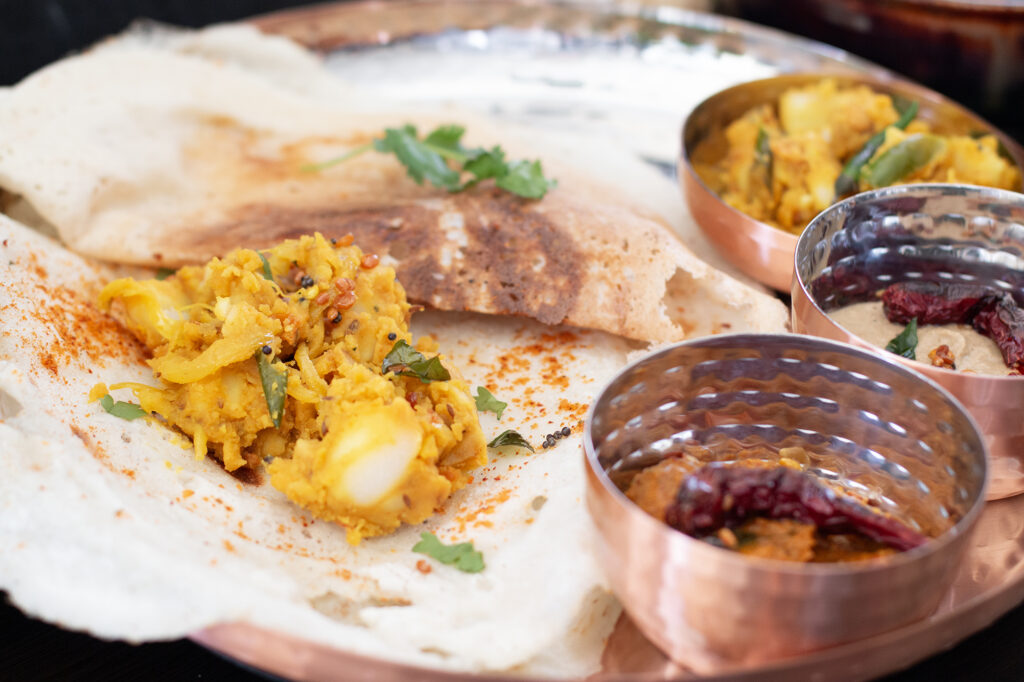
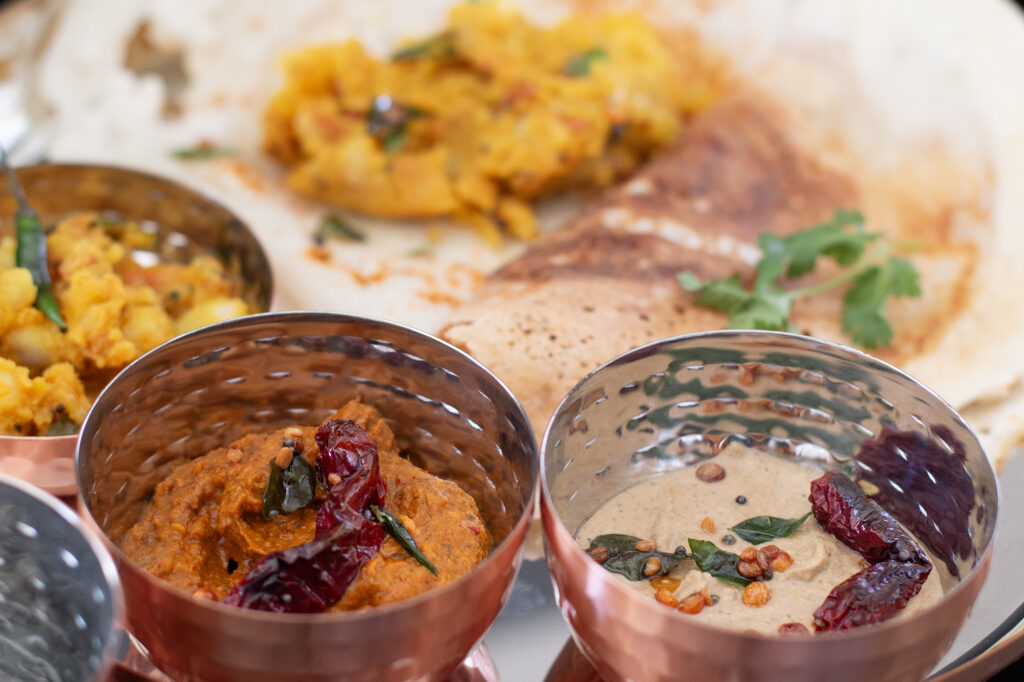

Dosas are served usually with a Sambhar, a Tomato Chutney and a Peanut Chutney.


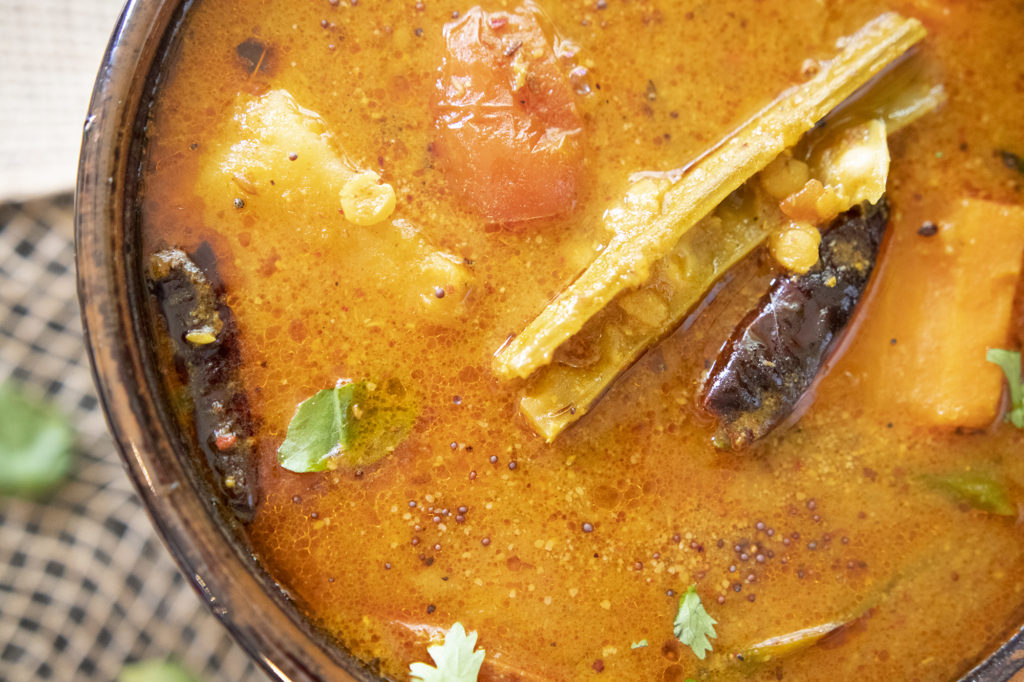
Why do we sprinkle Water on the hot pan?
Sprinkling water on a tava (griddle) before cooking dosa serves multiple purposes:
- Temperature Control – The tava is often too hot after making previous dosas. Sprinkling water cools it down slightly, preventing the batter from sticking or burning.
- Non-Stick Effect – The quick evaporation of water creates a thin steam layer, making the surface slightly non-stick, ensuring the dosa spreads evenly.
- Better Spreading – A tava that’s too hot causes the batter to cook too quickly before you can spread it properly. Cooling it slightly helps achieve a thin, even dosa.
- Test Readiness – The sizzling sound when water is sprinkled helps gauge if the tava is at the right temperature (it should evaporate quickly but not instantly).
Pro Tips
🔥 Tava Prep & Temperature
- Choose the right tava – A cast iron or heavy non-stick tava works best. Avoid a very smooth non-stick pan, as it may not allow even spreading.
- Heat it properly – Before pouring batter, the tava should be hot but not smoking. Sprinkle water to check:
- If water evaporates instantly, it’s too hot—cool it down.
- If water sits for too long, it’s too cold—heat it a bit more.
- Lightly grease – Rub a cut onion or half potato dipped in oil to create a non-stick effect. Avoid excess oil before spreading the batter, or dosa won’t spread properly.
🥞 Perfect Batter Consistency - Thin, flowing batter – The batter should be slightly thinner than pancake batter but not watery. Too thick = soft dosas, too thin = breaks apart.
- Fermentation matters – Well-fermented batter (bubbly & slightly sour) gives the best crispy texture. Keep it in a warm place for 8-12 hours.
🍽️ Cooking & Spreading - Spread in a spiral motion – Pour a ladleful of batter at the center and quickly spread outward in circular motions using the back of the ladle.
- Cook on medium heat – High heat can burn the dosa before it crisps up.
- Use the right oil – Ghee or butter gives a rich, crispy dosa. Regular oil works too, but don’t overuse it.
🔄 Flip or Not? - No need to flip for thin, crispy dosas – Just cook uncovered until golden brown.
- For thicker dosas, flip once and cook briefly on the other side.
Bonus Tip: Add a few drops of ghee on the edges for an extra crispy bite! 🧈🔥
Want specific dosa variations (like masala dosa or neer dosa)? 😃
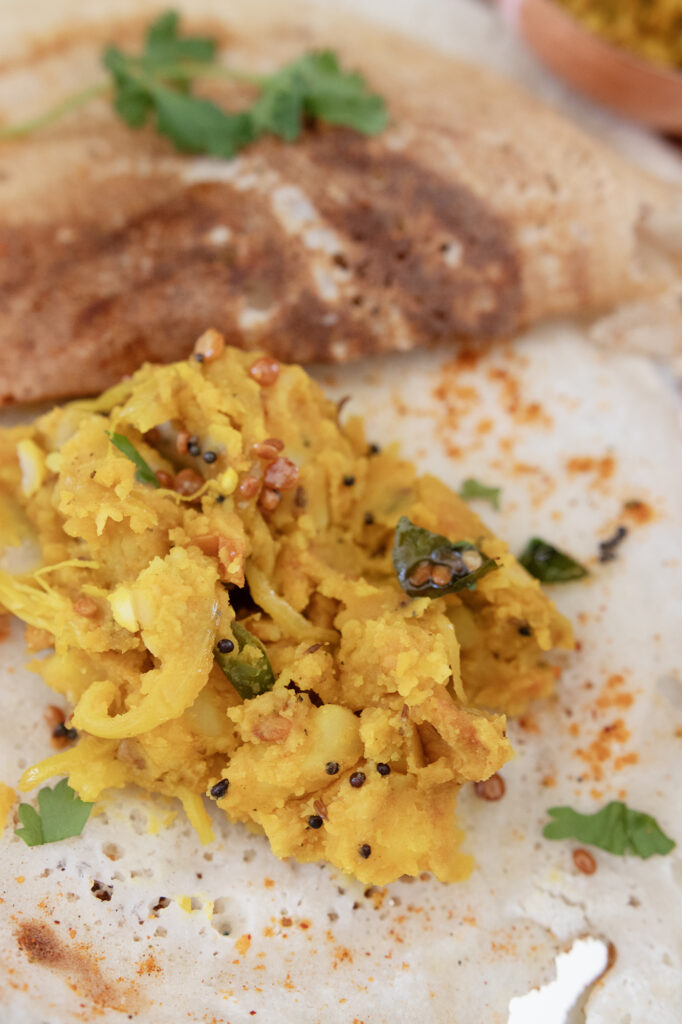
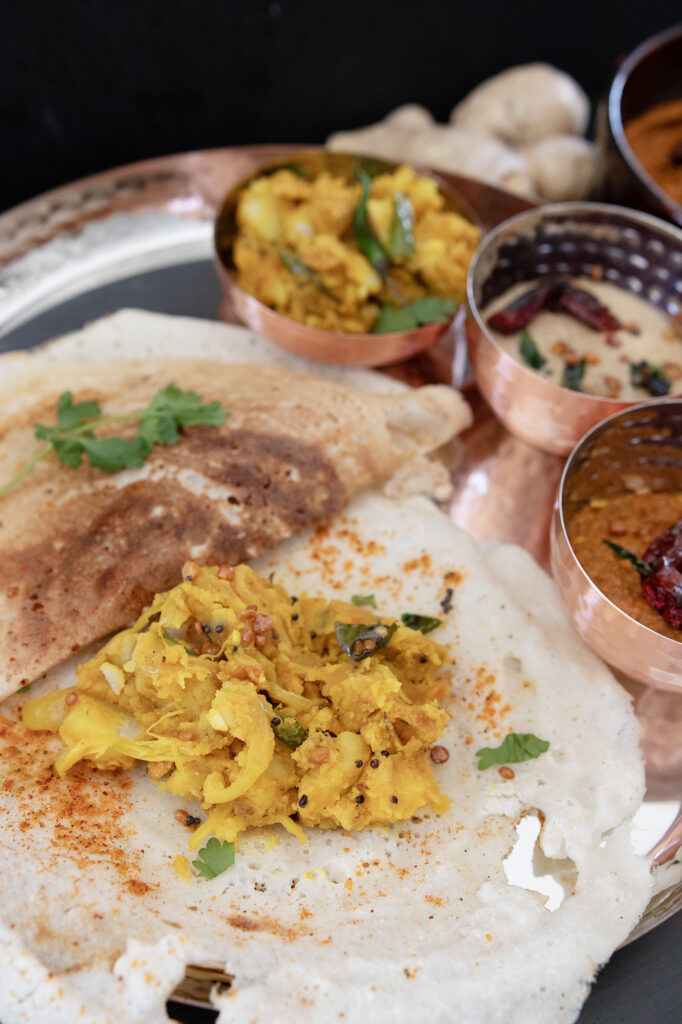
To ensure your Dosa’s don’t stick to your pan, make sure it’s well seasoned. Usually this gets naturally seasoned over time. If using a new pan, wash thoroughly, grease, heat, allow to smoke, cool, heat and cool about 3 times.
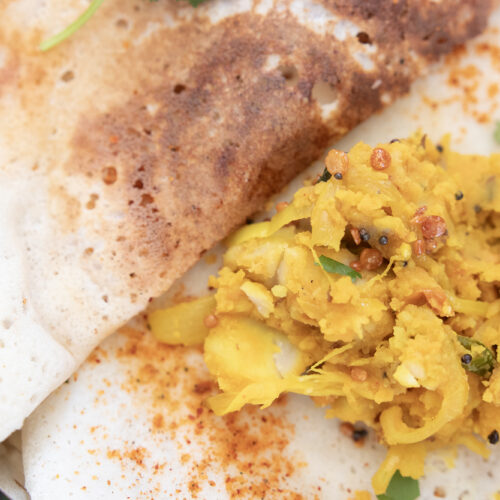
Dosa
Ingredients
- 3 cups Sona Masoorior Idli Rice
- 1 cup whole Urad Dhal
- 1/4 cup Chana Dhal
- 1 tsp Fenugreek seeds
- 1/2 cup flattened Rice or Poha
- Water as needed
- Salt to taste
Instructions
- Soak the Rice for 5 hours
- Soak the Urad, Chana Dhal & Fenugreek seeds for 3 – 5 hours
- Rinse & drain both the rice and the dhals separately
- Also soak the flattened Rice or Poha
- Grind the Urad, Chana Dhal & Fenugreek seeds in additions
- Add water as needed
- Because I don’t have a wet grinder, I am adding these in so that it grinds smooth without overheating my machine.
- Also stop and start your machine, giving the motor a chance to cool in between
- If you were to use a wet grinder, you could add all the lentils in at one time
- Transfer this to a pot for fermenting
- Once all the lentils are ground, add the rice in additions
- Also add a little water in between
- Pour this over the lentil batter
- In the last batch, add in the soaked Poha & Salt to taste
- Mix everything well together
- This needs to ferment for 6 – 12 hours depending on how warm it is where you are
- Cover this with a lid and stick it in a warm place like an oven with the light on.
- You can also use an Instant pot, with a lid on on Yogurt mode for 8 hours (not longer)
- You will know your batter s ready when it had increased in size, it had bubbles when you stir it and it has a sour smell
- You will need to add a little water to thin it down a little bit
- Before you start to make the dosa, you will need a flat non stick Tava or frying pan with a good non stick coating
- Grease the tava but wipe off the excess oil
- Sprinkle some Water on the hot tava and using a katori or a small bowl, or a ladle,pour the batter in the centre of the pan and then using the bowl, spread the batter thinly and evenly, starting from the center and moving outwards in a circular motion.
- You don’t nee to flip the dosas over, just sprinkle some oil, or you can also add butter, and some idli podi which is a special combination of chillies and other spices
- You can add chilli powder or leave it out
- Serve this with a Potato bhaji, Peanut & Tomato chutney

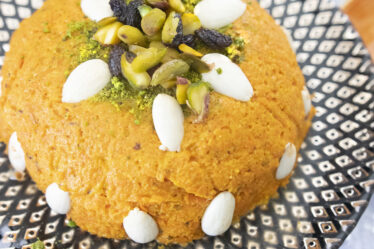
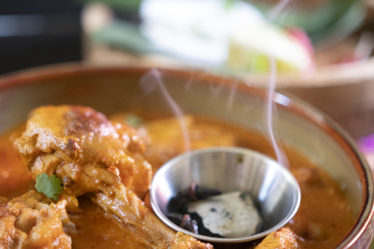

Hi my loved one! I wish to say that this post is amazing, nice written and include approximately all vital infos. I’d like to peer more posts like this.
taedra
https://pinupaz.top/# pinup az
discreet shipping: secure checkout Viagra – fast Viagra delivery
Viagra without prescription: best price for Viagra – cheap Viagra online
secure checkout Viagra: Viagra without prescription – order Viagra discreetly
modafinil pharmacy: legal Modafinil purchase – safe modafinil purchase
cheap Viagra online: buy generic Viagra online – legit Viagra online
Cialis without prescription: generic tadalafil – buy generic Cialis online
generic sildenafil 100mg [url=https://maxviagramd.com/#]same-day Viagra shipping[/url] same-day Viagra shipping
secure checkout Viagra: discreet shipping – cheap Viagra online
Cialis without prescription: discreet shipping ED pills – secure checkout ED drugs
http://maxviagramd.com/# safe online pharmacy
best price Cialis tablets: cheap Cialis online – Cialis without prescription
discreet shipping ED pills: Cialis without prescription – best price Cialis tablets
safe modafinil purchase [url=http://modafinilmd.store/#]Modafinil for sale[/url] buy modafinil online
fast Viagra delivery: Viagra without prescription – discreet shipping
generic tadalafil: cheap Cialis online – reliable online pharmacy Cialis
discreet shipping ED pills: affordable ED medication – secure checkout ED drugs
buy modafinil online [url=https://modafinilmd.store/#]buy modafinil online[/url] modafinil 2025
cheap Viagra online: same-day Viagra shipping – buy generic Viagra online
legit Viagra online: no doctor visit required – buy generic Viagra online
fast Viagra delivery: Viagra without prescription – generic sildenafil 100mg
safe online pharmacy [url=https://maxviagramd.com/#]order Viagra discreetly[/url] fast Viagra delivery
buy modafinil online: modafinil legality – doctor-reviewed advice
legal Modafinil purchase: legal Modafinil purchase – modafinil pharmacy
secure checkout Viagra: Viagra without prescription – legit Viagra online
best price Cialis tablets: discreet shipping ED pills – reliable online pharmacy Cialis
safe modafinil purchase: Modafinil for sale – doctor-reviewed advice
cheap Cialis online [url=https://zipgenericmd.com/#]secure checkout ED drugs[/url] online Cialis pharmacy
secure checkout Viagra: order Viagra discreetly – safe online pharmacy
trusted Viagra suppliers: safe online pharmacy – order Viagra discreetly
verified Modafinil vendors [url=https://modafinilmd.store/#]Modafinil for sale[/url] modafinil legality
safe online pharmacy: generic sildenafil 100mg – discreet shipping
buy modafinil online: modafinil 2025 – purchase Modafinil without prescription
FDA approved generic Cialis: generic tadalafil – secure checkout ED drugs
no doctor visit required [url=http://maxviagramd.com/#]same-day Viagra shipping[/url] fast Viagra delivery
trusted Viagra suppliers: generic sildenafil 100mg – secure checkout Viagra
affordable ED medication: secure checkout ED drugs – FDA approved generic Cialis
modafinil pharmacy: modafinil pharmacy – modafinil legality
trusted Viagra suppliers [url=https://maxviagramd.shop/#]secure checkout Viagra[/url] cheap Viagra online
secure checkout ED drugs: secure checkout ED drugs – buy generic Cialis online
cheap prednisone 20 mg: PredniHealth – PredniHealth
cost of cheap clomid without a prescription: cost generic clomid without a prescription – can you buy generic clomid
Amo Health Care [url=https://amohealthcare.store/#]Amo Health Care[/url] Amo Health Care
where buy cheap clomid without prescription: how can i get cheap clomid for sale – cost of generic clomid without insurance
PredniHealth: PredniHealth – mail order prednisone
amoxicillin 500 mg without prescription: Amo Health Care – Amo Health Care
Amo Health Care [url=https://amohealthcare.store/#]Amo Health Care[/url] amoxicillin buy online canada
buy amoxicillin 500mg uk: amoxicillin 500 coupon – generic amoxil 500 mg
PredniHealth: prednisone 10 mg canada – order prednisone 10 mg tablet
how to get amoxicillin over the counter: amoxicillin generic brand – rexall pharmacy amoxicillin 500mg
how can i get clomid without a prescription [url=http://clomhealth.com/#]can i purchase clomid without insurance[/url] where to get cheap clomid without dr prescription
Amo Health Care: price for amoxicillin 875 mg – amoxicillin 200 mg tablet
PredniHealth: prednisone tablets canada – prednisone cream over the counter
where to buy cheap clomid tablets: where can i buy clomid – where to get generic clomid online
Amo Health Care: Amo Health Care – Amo Health Care
Amo Health Care [url=https://amohealthcare.store/#]Amo Health Care[/url] Amo Health Care
PredniHealth: PredniHealth – where to buy prednisone without prescription
Amo Health Care: Amo Health Care – Amo Health Care
PredniHealth [url=http://prednihealth.com/#]PredniHealth[/url] PredniHealth
PredniHealth: prednisone 20mg cheap – prednisone pack
PredniHealth: PredniHealth – buy prednisone online no script
order prednisone on line: order prednisone with mastercard debit – PredniHealth
PredniHealth [url=https://prednihealth.com/#]prednisone online paypal[/url] prednisone pills for sale
Amo Health Care: generic amoxicillin 500mg – Amo Health Care
PredniHealth: PredniHealth – PredniHealth
where to buy clomid without dr prescription [url=https://clomhealth.com/#]Clom Health[/url] cheap clomid pill
Amo Health Care: Amo Health Care – Amo Health Care
cialis in canada [url=https://tadalaccess.com/#]cialis soft tabs[/url] canada pharmacy cialis
over the counter drug that works like cialis: tadalafil and voice problems – cialis 5 mg
prices on cialis: Tadal Access – which is better cialis or levitra
cialis tadalafil online paypal: Tadal Access – cialis and melanoma
pastilla cialis [url=https://tadalaccess.com/#]Tadal Access[/url] cialis 5 mg price
tadalafil generic 20 mg ebay: best price on cialis – cheap cialis with dapoxetine
generic cialis super active tadalafil 20mg: Tadal Access – cialis shelf life
cialis 5 mg: Tadal Access – vardenafil and tadalafil
tadalafil long term usage [url=https://tadalaccess.com/#]purchasing cialis[/url] tadalafil professional review
4v8cba
cialis paypal canada: Tadal Access – tadalafil citrate liquid
cialis for daily use: cialis 80 mg dosage – buy cipla tadalafil
buy cialis online reddit [url=https://tadalaccess.com/#]TadalAccess[/url] tadalafil eli lilly
cialis daily review: cialis canada sale – recreational cialis
does cialis shrink the prostate: centurion laboratories tadalafil review – does cialis shrink the prostate
tadalafil ingredients [url=https://tadalaccess.com/#]TadalAccess[/url] tadalafil walgreens
when does cialis go off patent: TadalAccess – cialis dapoxetine overnight shipment
how long does cialis take to work 10mg: cialis generic overnite shipping – where can i buy cialis on line
cialis genetic [url=https://tadalaccess.com/#]TadalAccess[/url] cialis canada online
where to get free samples of cialis: TadalAccess – tadalafil tablets erectafil 20
cialis otc 2016: Tadal Access – does cialis lowers blood pressure
purchasing cialis [url=https://tadalaccess.com/#]TadalAccess[/url] cialis free
side effects of cialis daily: Tadal Access – best price on generic tadalafil
cialis max dose: cialis next day delivery – best reviewed tadalafil site
cialis super active real online store [url=https://tadalaccess.com/#]Tadal Access[/url] buy voucher for cialis daily online
cheapest cialis online: cialis coupon code – how to get cialis for free
generic cialis: buy cialis online in austalia – cialis free 30 day trial
where to buy cialis over the counter: Tadal Access – cialis and grapefruit enhance
tadalafil soft tabs: TadalAccess – cialis paypal canada
canadian pharmacy ezzz cialis [url=https://tadalaccess.com/#]Tadal Access[/url] how long does cialis take to work
when will generic cialis be available in the us: Tadal Access – cialis before and after photos
natural cialis: Tadal Access – cialis 40 mg reviews
what does cialis do: Tadal Access – what does cialis cost
buy cialis with american express [url=https://tadalaccess.com/#]cialis side effects a wife’s perspective[/url] oryginal cialis
cialis cheapest price: how to get cialis without doctor – cialis patent expiration date
side effects of cialis: cialis generics – ambrisentan and tadalafil combination brands
dapoxetine and tadalafil [url=https://tadalaccess.com/#]Tadal Access[/url] canadian pharmacy cialis 40 mg
where to buy generic cialis ?: cialis daily side effects – cialis prices
cialis online usa: TadalAccess – buy cialis in canada
cialis in las vegas: cialis 5mg daily how long before it works – cialis no prescription
where can i buy tadalafil online: Tadal Access – prescription for cialis
no prescription female cialis [url=https://tadalaccess.com/#]Tadal Access[/url] cialis 5 mg for sale
cialis without prescription: where to buy generic cialis ? – cheap cialis dapoxitine cheap online
buy cialis online in austalia: TadalAccess – when to take cialis 20mg
cialis tablets [url=https://tadalaccess.com/#]Tadal Access[/url] tadalafil cost cvs
cialis for daily use side effects: TadalAccess – cialis bodybuilding
cialis for bph insurance coverage: mint pharmaceuticals tadalafil reviews – cialis coupon online
https://tadalaccess.com/# cialis canada over the counter
how much does cialis cost at cvs [url=https://tadalaccess.com/#]buy liquid cialis online[/url] what does cialis treat
cialis for daily use side effects: Tadal Access – cialis for daily use
non prescription cialis: mail order cialis – buy voucher for cialis daily online
purchase cialis [url=https://tadalaccess.com/#]Tadal Access[/url] tadalafil citrate
tadalafil soft tabs: Tadal Access – cialis walgreens
cialis reviews photos: TadalAccess – where to buy cialis
cialis erection [url=https://tadalaccess.com/#]tadalafil best price 20 mg[/url] cialis soft tabs canadian pharmacy
cialis australia online shopping: TadalAccess – buy cialis without prescription
cialis max dose: Tadal Access – where can i buy cialis over the counter
cialis canada pharmacy no prescription required: TadalAccess – ambrisentan and tadalafil combination brands
generic cialis from india [url=https://tadalaccess.com/#]tadalafil tamsulosin combination[/url] cialis 40 mg reviews
cialis free trial 2018: TadalAccess – paypal cialis no prescription
where can i buy cialis on line: TadalAccess – when will teva’s generic tadalafil be available in pharmacies
tadalafil eli lilly [url=https://tadalaccess.com/#]TadalAccess[/url] how to take cialis
cialis pills for sale: cialis prices – canada drug cialis
wallmart cialis: cialis contraindications – cialis and high blood pressure
non prescription cialis [url=https://tadalaccess.com/#]Tadal Access[/url] does cialis shrink the prostate
when will cialis become generic: tadalafil citrate liquid – does tadalafil lower blood pressure
super cialis: TadalAccess – trusted online store to buy cialis
levitra vs cialis [url=https://tadalaccess.com/#]Tadal Access[/url] cialis samples
cialis super active reviews: how long for cialis to take effect – where to buy generic cialis ?
cialis tablets: cialis tadalafil 5mg once a day – trusted online store to buy cialis
cialis bathtub [url=https://tadalaccess.com/#]when will cialis become generic[/url] does cialis really work
cialis dosis: Tadal Access – cialis over the counter in spain
cialis samples: TadalAccess – cialis and high blood pressure
cialis 20 mg best price [url=https://tadalaccess.com/#]cialis for sale brand[/url] cialis and high blood pressure
side effects of cialis daily: Tadal Access – what is the difference between cialis and tadalafil
cialis 20mg: TadalAccess – cialis generic for sale
cialis tadalafil 20mg tablets [url=https://tadalaccess.com/#]Tadal Access[/url] cialis 20mg tablets
best place to buy tadalafil online: recreational cialis – is tadalafil peptide safe to take
best research tadalafil 2017: TadalAccess – cialis dosis
cialis professional 20 lowest price [url=https://tadalaccess.com/#]cialis dosage for bph[/url] cialis online delivery overnight
cialis insurance coverage: cheap canadian cialis – buy cialis online overnight delivery
cialis alternative over the counter: cialis 5 mg tablet – cheap cialis
cialis free trial voucher 2018: reddit cialis – cialis 10mg reviews
canadian pharmacy ezzz cialis [url=https://tadalaccess.com/#]Tadal Access[/url] cheap cialis with dapoxetine
cialis online no prior prescription: is tadalafil peptide safe to take – can i take two 5mg cialis at once
when will cialis be over the counter: tadalafil lowest price – cialis no perscrtion
cialis free samples [url=https://tadalaccess.com/#]TadalAccess[/url] buy cialis 20 mg online
cialis using paypal in australia: cialis free trial voucher – price of cialis in pakistan
cialis before and after photos [url=https://tadalaccess.com/#]cialis free trial voucher[/url] cialis medicine
tadalafil with latairis: active ingredient in cialis – is tadalafil available in generic form
what is cialis good for: Tadal Access – cialis purchase
https://tadalaccess.com/# cialis over the counter in spain
tadalafil 20 mg directions [url=https://tadalaccess.com/#]Tadal Access[/url] cialis stories
cialis alcohol: canada cialis – cialis amazon
cialis 5mg daily [url=https://tadalaccess.com/#]cialis coupon walgreens[/url] cialis over the counter in spain
cialis for prostate: TadalAccess – cialis generic release date
can you drink alcohol with cialis: Tadal Access – cialis 20mg side effects
cialis 20 mg tablets and prices [url=https://tadalaccess.com/#]does cialis lower your blood pressure[/url] buy cialis usa
cialis free trial: cialis commercial bathtub – when is generic cialis available
https://tadalaccess.com/# what is the generic for cialis
cialis generic timeline [url=https://tadalaccess.com/#]TadalAccess[/url] cialis tablets for sell
cialis using paypal in australia: TadalAccess – is tadalafil the same as cialis
cialis coupon walmart [url=https://tadalaccess.com/#]Tadal Access[/url] non prescription cialis
where to buy cialis in canada: cialis free – can you purchase tadalafil in the us
cialis no prescription: Tadal Access – is there a generic equivalent for cialis
generic tadalafil cost [url=https://tadalaccess.com/#]Tadal Access[/url] no prescription tadalafil
generic cialis: cialis softabs online – cialis contraindications
tadalafil price insurance [url=https://tadalaccess.com/#]Tadal Access[/url] cialis savings card
cialis for sale in toront ontario: Tadal Access – how to get cialis for free
generic tadalafil tablet or pill photo or shape [url=https://tadalaccess.com/#]Tadal Access[/url] maximum dose of cialis in 24 hours
cialis price comparison no prescription: TadalAccess – tadalafil citrate liquid
cialis 800 black canada [url=https://tadalaccess.com/#]india pharmacy cialis[/url] cialis dosage for bph
cialis buy australia online: Tadal Access – cialis 100mg review
cialis generic best price [url=https://tadalaccess.com/#]when is generic cialis available[/url] order cialis soft tabs
reddit cialis: TadalAccess – tadalafil dapoxetine tablets india
does cialis lowers blood pressure [url=https://tadalaccess.com/#]can tadalafil cure erectile dysfunction[/url] cialis 20 mg
generic cialis tadalafil 20 mg from india: buying cialis online usa – cheap canadian cialis